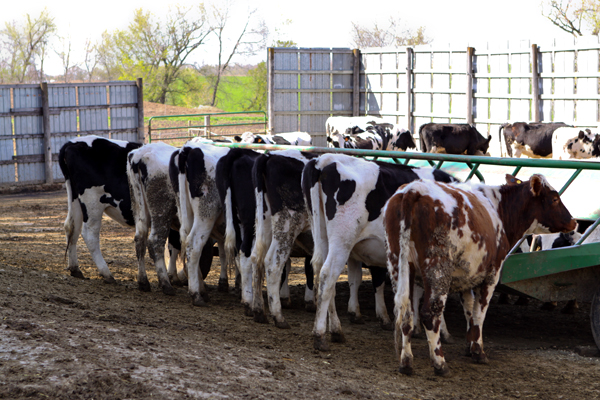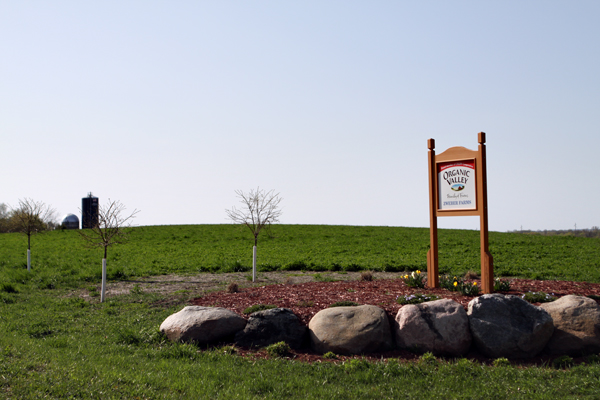
Since we were young, we were told to drink our milk to build strong bones. A cold glass of milk was always there at the dinner table, in our cereal bowls, and served alongside a gooey chocolate chip cookie popped right out of the oven. But besides the bit of trivia that a glass of milk can cool off a spicy mouth (FYI — beer also does the trick) and the generalities of the milk processing cycle from cow to processor to store, I’m willing to bet that most of us don’t really know much about the milk industry, milk pricing, or the farmers who keep our Cheerios and Lucky Charms in such good company.
The Heavy Table visited Zweber Farms, a Minnesota organic dairy farm that’s a member of Organic Valley, the second largest dairy cooperative in the US, to get an inside look at some aspects of the modern dairy industry.
First, a bit of an overview on the milk industry. The US dairy industry has grown over the past 20 years, and its success is hugely important to the economy of the Upper Midwest; with more than 22,000 million pounds produced annually, Wisconsin is the nation’s second biggest milk producer after California, and Minnesota is ranked sixth.
The milk industry has followed natural industry cycles, including dramatic increases in wholesale prices due to high demand and low supply of product. With the advent of the recession, the industry took a dive in late 2008 and early 2009. A drastic decrease in global demand for dairy products due to the recession left the US industry with a milk surplus. In milk pricing terms, which is measured by price per hundred pound weight (cwt), the price dropped from $17.10 cwt in November 2009 to $11.60 cwt in February 2010. The industry did not see an increase above $12 cwt until August of last year.
With prices dropping and a surplus in supply, many farmers were forced out of the market. Although no one can escape such industry changes, those who were receiving conventional pricing for their milk were most typically affected more. Conventional milk pricing follows the unpredictable market as a whole, while organic pricing is driven by generally more stable negotiated contracts.
Dairy cooperatives, economic units composed of numerous individual dairy farmers, can provide additional stability in a volatile business. Organic Valley Chief Marketing Officer Theresa Marquez explains, “The cooperative is a vehicle in which all the members say, ‘Let’s share the wealth.'”
Marquez explains how Organic Valley got its start: “The co-op was birthed in 1988 when there was a tremendous crisis in the farming community where farmers were going out of business.” At that point in time, milk prices had fallen to $10 for 100 pounds of milk, or 10 cents a pound.
“At that point in time, the farmers said, ‘Wow, what are we going to do…?’ So they decided to form [an organic] cooperative, because they knew that selling in the conventional way was not going to bring about a fair pay price.”

Zweber Farms
Zweber Farms dates back to 1906 with a history that includes raising cattle and pigs, as well as cropping until they turned their focus to grazing. “Early 90s we started grazing cows,” says Tim Zweber. “We needed to have more cows to support our family so it was either add on to the barn or do something different. So we just kicked the cows out of the barn and put them in the pasture and it’s been that way since.” Zweber and his wife Emily run the 98-cow farm today, partnering with his parents Jon and Lisa.
As far as Zweber can remember, the farm has been part of a dairy cooperative — recently it was Hastings Cooperative, a conventional cooperative run out of Hastings, MN. In 2006, the Zweber farm decided to make the change to organic dairy farming, which necessitated a change in dairy cooperatives.
In explaining their desire to stay within the cooperative system, Zweber explains: “There are plenty of organic farmers that aren’t in co-ops. Some of them have lost their contracts to ship milk and if you have no contract you have nowhere to go with your milk. Then you have to try to go to a conventional co-op or another organic co-op to take it. It’s not like you can hold onto it, like grain. It has to go out every other day, minimum.”
“There were lots of choices at the time we went organic,” says Emily. “Organic Valley seemed like the least risky company to go with. [They have] been around for 20 plus years. They have a good reputation; we had lots of friends, and a lot of people in our county, who had really positive things to say. And there was infrastructure (a milk truck already coming this way).”
“You don’t want to be the last guy on the milk truck route way far away,” Zweber chimes in, “because you’d be the first one that they’d be looking at to dump off if times got a little hard.”

The Zwebers also found comfort in Organic Valley’s pricing structure, which pays a set price regardless of whether the farm’s milk is used for fluid milk (the highest paying commodity), dry milk, or other less perishable items like yogurt and cottage cheese. “With Organic Valley, everyone is working together. You don’t look at [it as], ‘My milk goes into this, so I should get paid more.’ Any given person’s milk can be turned into whatever depending on what kind of plant you’re closest to. If you’re close to a cheese plant or a fluid milk plant, then that’s where you’re milk’s going.”
Although he knows his milk goes to Schroeder Dairy to be processed and packaged under the Organic Valley label, he states: “It doesn’t really matter too much because we get the same price.”
Zweber continues: “See, once the milk leaves here it enters a whole world of packaging and marketing that is really not anything that we would have the time or ability to do, unless we were bottling it on our own farm. That’s why farmers are in these large co-ops. That’s why it’s set up the way it is. The co-ops know what demand they have for what products, and at what time. Since milk is so perishable, you have to make a decision that minute [about] where it’s going.”

For the Locavore
One question that is on the forefront of this writer’s mind when shopping for milk at the local food coop is, How local are these products? How far did they have to ship for bottling? This particularly seems pertinent when the product is not associated with a single farm, like the Organic Valley brand of milk.
Emily explains: “Milk is highly perishable so it just makes economic sense to not to truck it very far. So milk, no matter what brand you buy, most likely will be local. Well, at least within Minnesota and Wisconsin, it will be.”
Organic Valley contracts with dairy processors locally. In Minnesota, their contract is with Schroeder Dairy.
Despite these commitments, there may be times when supply demands a non-local product. Zweber shares a recent story of this, which came about via Twitter.
“Someone in New York saw their milk was from Minnesota. That will happen if there is a shortage in New York, but it’s not that we’re always shipping our milk out to New York. This person said, ‘I checked my milk and it was from Minnesota,’ and then another person on Twitter who followed us put us in the conversation and said, ‘I think Zweber Farms ships to Organic Valley.’ And so I checked that and saw what she was wondering about. I said, “That’s kind of odd; I don’t know why my milk would be out there. But go buy another thing of milk and check if that’s still from Minnesota and then give me a call and I’ll check on why on Earth my milk is out there but…thanks a lot for purchasing my product!” She was perfectly happy to support a farmer in Minnesota, but she was just wondering why on Earth it was from there. So I called Organic Valley and checked into it. [It was due to an issue with the half-gallon bottling machine in New York.] And that’s how you get Minnesota milk in New York.”
For anyone interested in finding out where their milk is from, check out this website.

Why not organic?
Given the considerably more stable conditions within the organic milk pricing model, it is reasonable to wonder why all farmers don’t go organic. But while there are many advantages, there are also several hurdles in transitioning to organic, including the time it takes to transition the land (3 years) and herd (1 year), as well as the additional costs of feed. Organic Valley assists transitioning farmers by offering a premium pay in recognition of the additional costs (for the Zwebers it was $2 cwt), while the farm continues to sell and ship their milk conventionally. Even though this sounds like a great opportunity to jump on, Marquez explains that Organic Valley is a closed co-op. Farmers cannot join without being invited, essentially limiting the number of new farms (five to six farms per $1 million in increased sales) to control their supply of milk.
Outlook
Given the market changes in the dairy industry, the future of milk prices is difficult to predict. Per a report presented in January 2010 by the USDA, the US should expect to see an increase in domestic and foreign demand. Combined with a decrease in domestic supply, predictions call for an increase to the milk prices, although not to the levels seen before the recession. In response, the US government has instituted several actions, including the formation of a Dairy Industry Advisory Committee to review the issues, such as milk price volatility and dairy farmer profitability, and make suggestions for improvement.


Comments are closed.